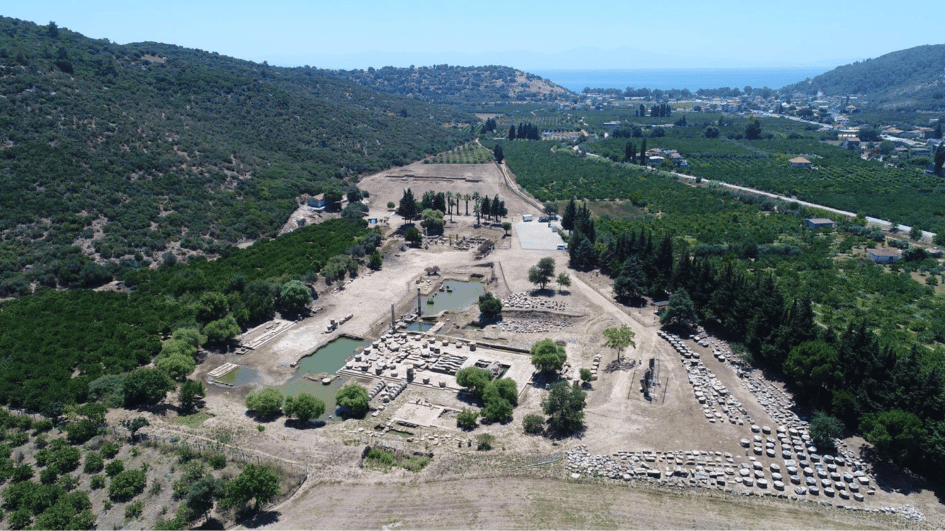
Excavations at Claros Sanctuary have been the longest-running excavations ongoing under Ege University's Archaeology Department, says excavation head Associate Professor Onur Zunal, while shedding light on how Claros emerged as a prophecy center in the past.
Located within the borders of İzmir’s Menderes neighborhood, the Claros Sanctuary is one of the most important sacred areas of Ionia, as well as the oldest oracle center, as proved by the excavations carried out so far.
It is located south of Menderes, on the bottom plain of the Ahmetbeyli Valley, which connects the plain to the Gulf of Kuşadası in the south. Ahmetbeyli Valley is an important junction point providing transportation between the cities of Smyrna and Ephesus. The main cities of Claros, an exurban sanctuary, are 13 kilometers away from Kolophon in the north and 1.6 kilometers away from Notion in the south.
Speaking about the first research carried out in the excavation area, Zunal said, “According to ancient texts and archaeological data, the first systematic research in Claros, which is known to have been founded in the 13th century B.C., was carried out by Carl Schuchhardt in 1886, while Theodor Macridy carried out the first excavation in 1907. He started excavations after making a small drilling there on the eroded surface of the only column left under the fill."
"Loius Robert and Jeanne Robert conducted excavational works between 1950 and 1961, while Juliette de La Genière carried out works between 1988 and 1997. Since 2001, Ege University faculty members and staff have been following up on excavations, research and restoration works there. Works were carried out under the direction of Nuran Şahin between 2001 and 2019 and have been ongoing under my scientific consultancy since 2020,” he added.
Stating that the monumental Hellenistic-era Temple of Apollo was one of the most important artifacts in Claros, as well as the cult statues of the temple, Zunal said: “These statues are the only Doric temple built in the Hellenistic period in Ionia. Its construction began at the beginning of the 3rd century B.C., and the temple's monumental cult statues were completed at the end of the 2nd century B.C. The temple has some unique features in terms of its plan. There are two different stairs in the north and south of the temple. The northern staircase is used by those entering the temple, and the southern staircase is used by those leaving the temple. Both stairs are connected to the tunnel-shaped corridor underground, which opens into two adytons [restricted areas] supported by arches."
"The front adyton was used as a waiting place for priests, clerks and those who applied for prophecy. The back adyton, where the holy water well is located, was the place where prophecy took place, and only the oracle of the god Apollo used this place. The cult statues of Apollo, Artemis and Leto inside the temple attract attention as unique examples found in an ancient sanctuary and temple, preserved in the best condition. The original height of the marble statues was 7 meters and their weight was around 25 tons,” he added.
Prophecy center, Claros
While speaking of Claros’s position as a center of prophecy, Zunal said: “Prophecy, which literally means making predictions about the future, was one of the tasks that Apollo was responsible for among the gods and goddesses who had different duties in the Greek pantheon. Beyond providing information about the future, prophecy also meant a religious phenomenon and obligation for Greek society. Especially when important decisions affecting the whole society were to be made, it was necessary to consult Apollon."
"It is also known that people came to Claros to solve their personal issues. In this sense, Apollo's prophecy feature is the main reason why Claros attracts many visitors. Standing out with this feature, Claros gained a great reputation in the 2nd century B.C. and received visitors from many cities from the distant borders of the Roman Empire,” he added.
Zunal said that inscriptions found in Claros revealed that delegations from many cities of different countries, such as Italy, Spain, England, Croatia, Bulgaria and Mauritania, came to Claros.
“What stands out in this sense is the foundation of Smyrna, the most famous prophecy given in Claros. According to the story, Alexander fell asleep on Pagos Hill after taking Smyrna. In his dream, the goddesses of Nemesis tell him to establish a city where he sleeps. Alexander sends one of his generals, Lysimachus, to Claros to have his dream interpreted. He received the answer from God, ‘the people who will live in Pagos outside the Holy Meles stream will be three or even four times happier’ and he founded New Smyrna in Pagos,” he said.